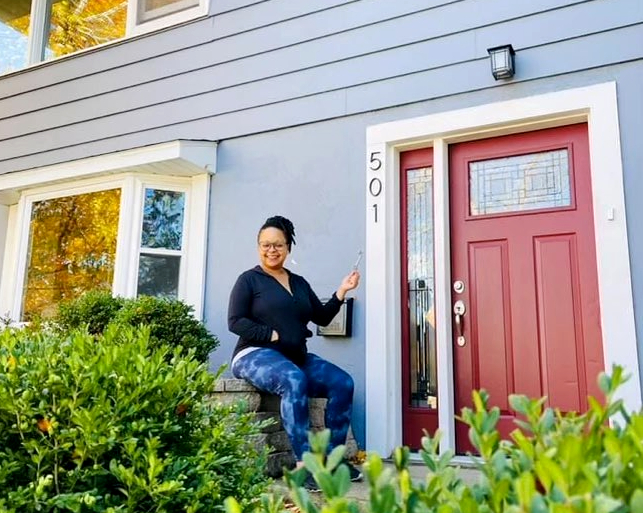
There are many ways to celebrate Black History and one thing is certain, we are good at celebrating. But this month, and throughout the year, we aim to balance celebration with a serious acknowledgment of how the history in the real estate industry has played a significant role in the extreme and glaring wealth gap that exists today.
In Wisconsin, homeownership among Black Americans is the third-lowest in the nation. Homeownership is the primary way that low- and moderate-income families are able to build wealth and achieve financial stability
In 2019, it was reported that the median white household held $188,200 in wealth, 7.8 times more than that of the typical Black household ($24,100). And in Dane County, while 64% of white families are homeowners, only 10% of Black families own their homes. Part of the problem lies with representation within the real estate industry (currently 78% of the members of the National Association of Realtors are white). But the bulk of the problem is the legacy of racist housing policy that existed through much of the twentieth century and the indifference to it.
America’s historical practice of race-based exclusion can be overwhelming but it’s critical we take the time to learn more if we want to do better.
The Hamilton Project, an economic policy initiative connected with the Brookings Institute, offers an overview of some of the obstacles that Black Americans have struggled against in “Examining the Black-White Wealth Gap”. The author writes:
“Efforts by Black Americans to build wealth can be traced back throughout American history. But these efforts have been impeded in a host of ways, beginning with 246 years of chattel slavery and followed by Congressional mismanagement of the Freedman’s Savings Bank (which left 61,144 depositors with losses of nearly $3 million in 1874), the violent massacre decimating Tulsa’s Greenwood District in 1921 (a population of 10,000 that thrived as the epicenter of African American business and culture, commonly referred to as “Black Wall Street”), and discriminatory policies throughout the 20th century…”
In the article, The Black History of Housing in America: How the Dream Was Deferred, Dr. Raphael Bostic explores the connection between the explicit denial of access to homeownership that Black people experienced in the past with the wealth gap today. “All across America, exclusionary zoning kept blacks out of white neighborhoods, and where it didn’t, the white neighborhoods put restrictive covenants in the deeds to the same effect. Even in the absence of legal constraints, real estate brokers steered blacks into poorer neighborhoods.” Dr. Raphael Bostic explores the connection between the explicit denial of access to homeownership that Black people experienced with the wealth gap today. “The National Association of Real Estate Boards explicitly instructed their members to keep blacks out of white neighborhoods.” The weight of our country’s history matters and the legacy of that history endures to this day.
There is so much more to learn, too. The book, Race for Profit, by Keeanga-Yamahtta Taylor requires a strong cup of coffee and a pen handy for taking notes.
Race for Profit delves into systemically racist real estate practices that continued well after housing discrimination was banned and how that same racist system remained intact even after prohibitions against redlining. Keeanga-Yamahtta Taylor explores how the close relationships between regulators and the industry served to create incentives that led to predatory practices in the world of real estate.
Though there have been many obstacles for Black Americans in the struggle for equality there have also been those that stood up to this reality of racism in America around real estate. In 1947, Black real estate brokers and agents who had been denied membership to the National Association of REALTORS (NAR) because of the color of their skin, created their own association, the National Association of Real Estate Brokers (NAREB) as an equal opportunity and civil rights advocacy organization for African American real estate professionals and their clients. Because the title of REALTOR was trademarked and reserved to members of the NAR, members of NAREB created the title of Realtists.
In the years after WWII housing demand, racial exclusion, and mob intimidation left Black Americans struggling to find housing. Robert Thompson, the Secretary of Urban League in Atlanta, came up with a plan to buy up over a thousand acres west of Atlanta for Black housing development called PROJECT X. The land outside the city limits was not subject to the racial zoning of Atlanta making it possible for Black people to purchase it legally. Thompson put together 23 investors and sold shares to fund this pursuit and they began to quietly buy up this land.
As Thomson’s corporation began buying up property after property, the racism indicative of the Jim Crow era drove down the value of the land. Throughout the 50’s these parcels would develop into a thriving middle-class Black community funded with Black wealth and developed with Black know-how to become Collier Heights. (Listen to this informative podcast if you want to know even more.)
Understanding how policies and practices have been fundamental to blocking Black homeownership in cities throughout the country creates opportunities to challenge and highlight where we can demand change. And where we can focus our own ways to build Black wealth, like Madison’s OWN IT: Building Black Wealth initiative, among others.
Learning more about the historical context is an important part of the work we do. It influences how we support our clients and our community and we promise to never forget. History matters. Homeownership matters.



